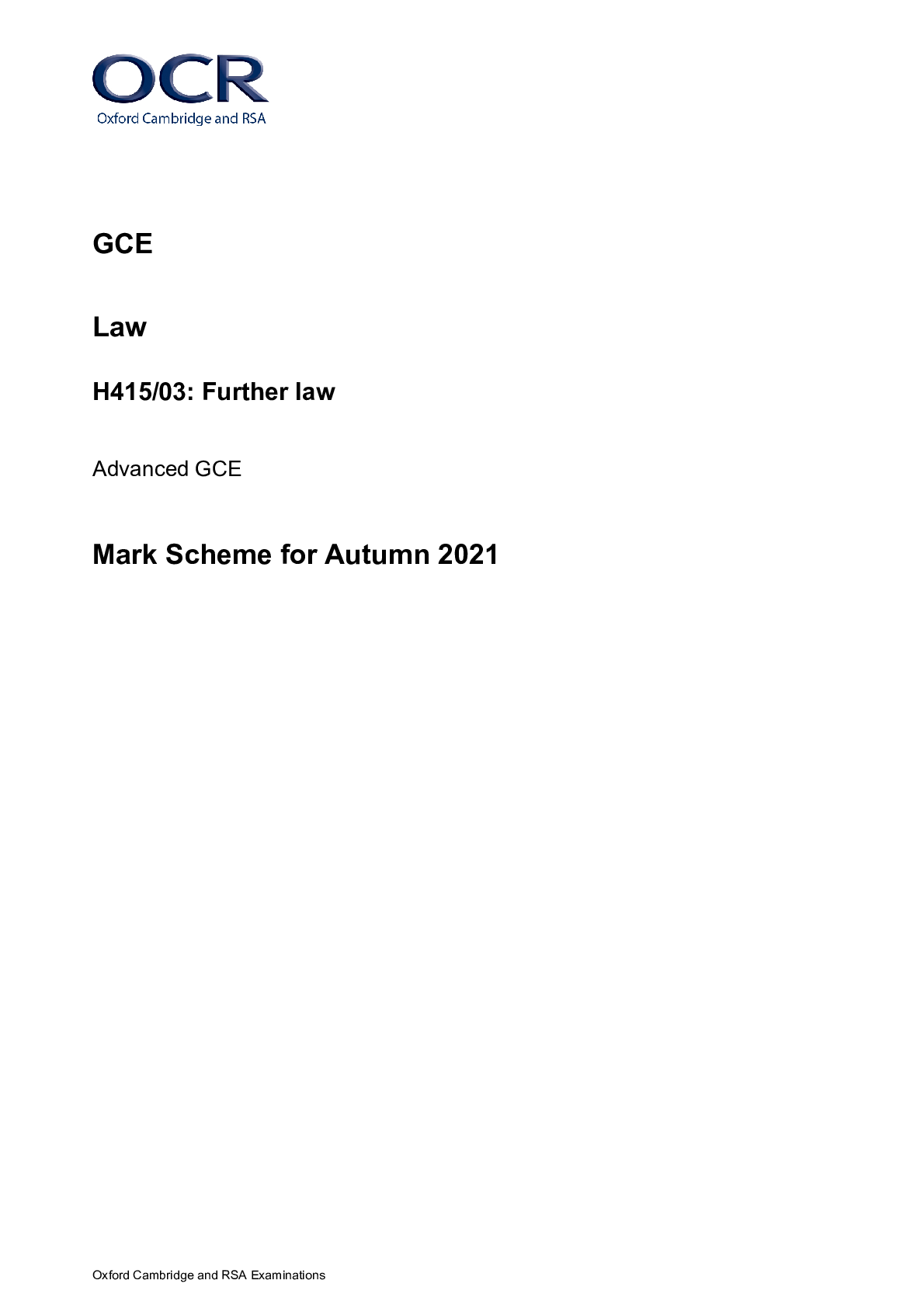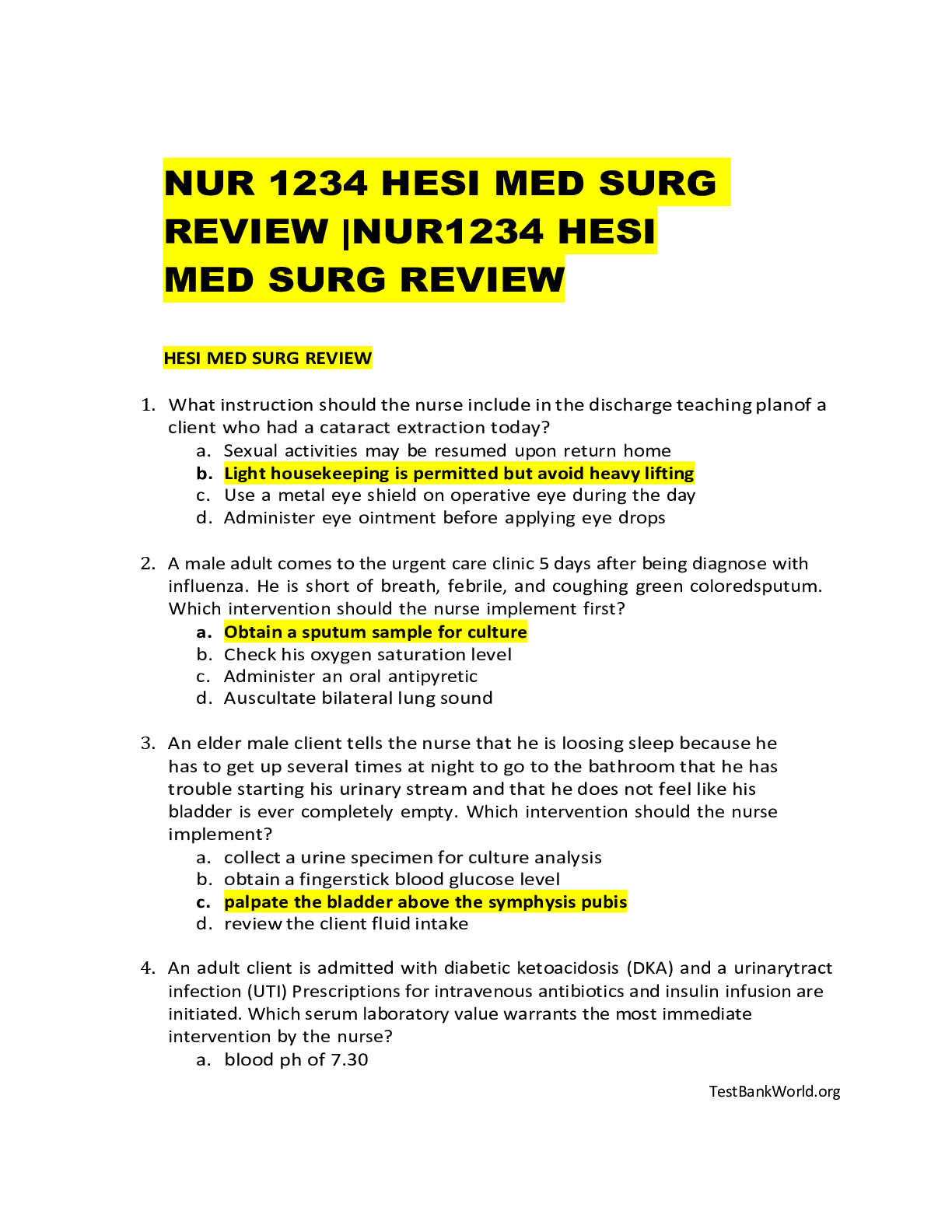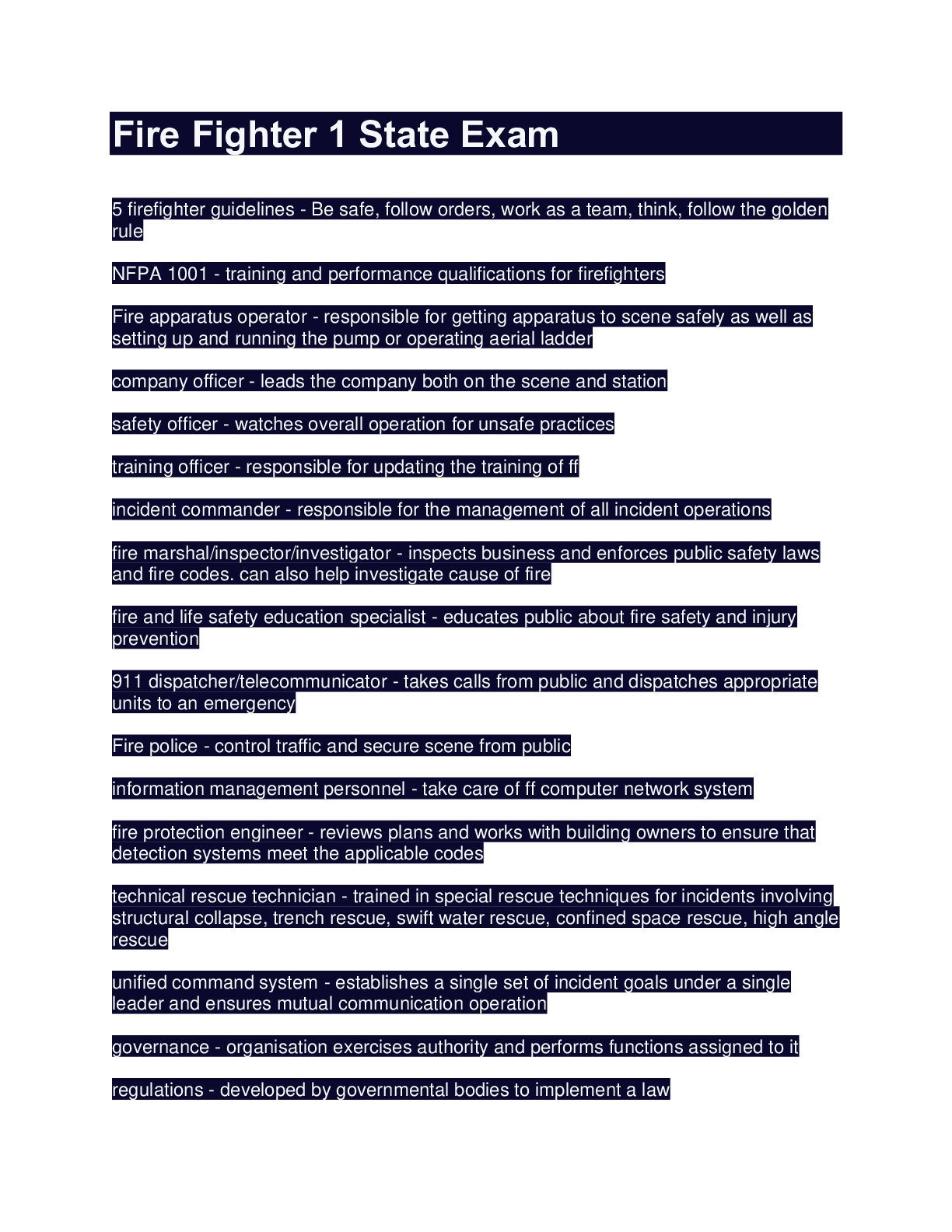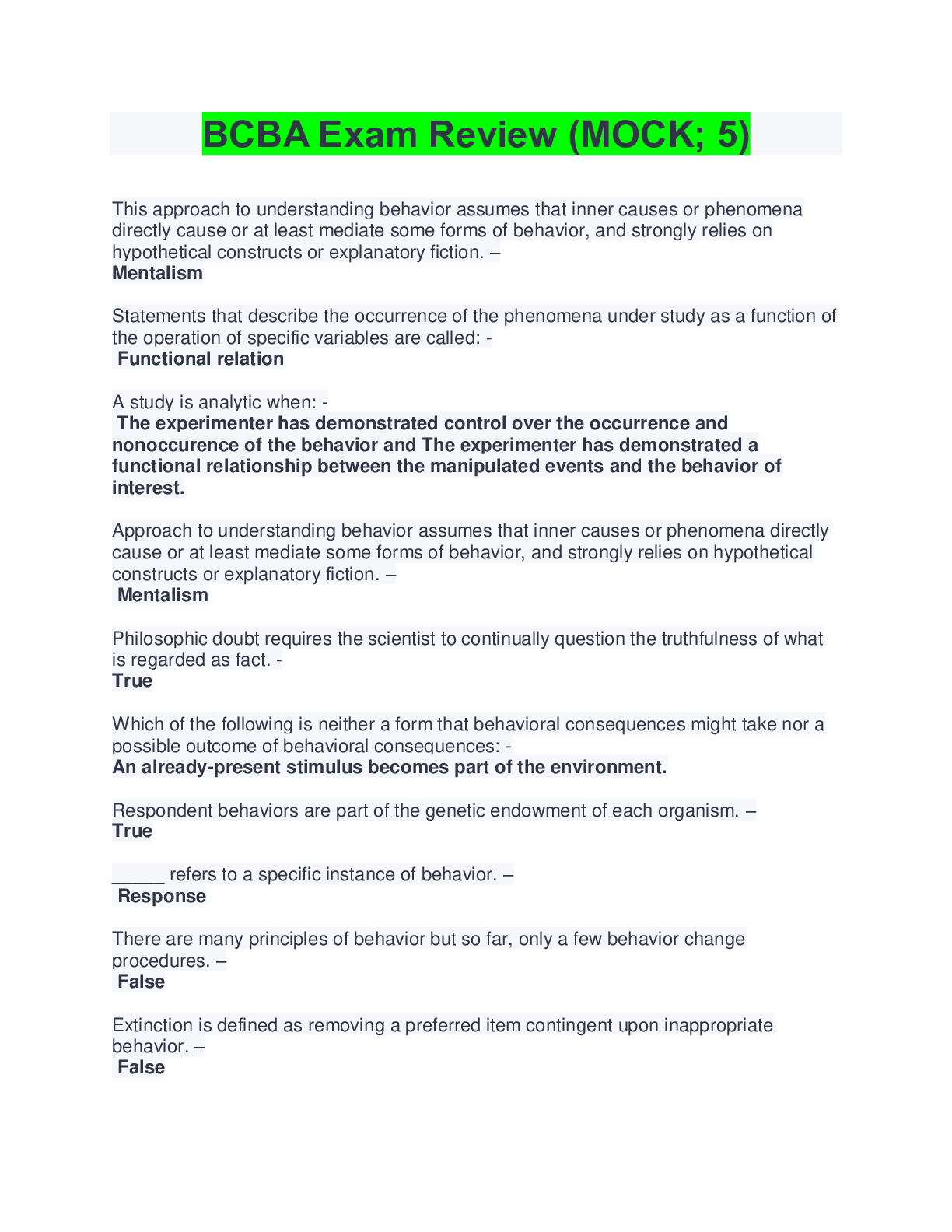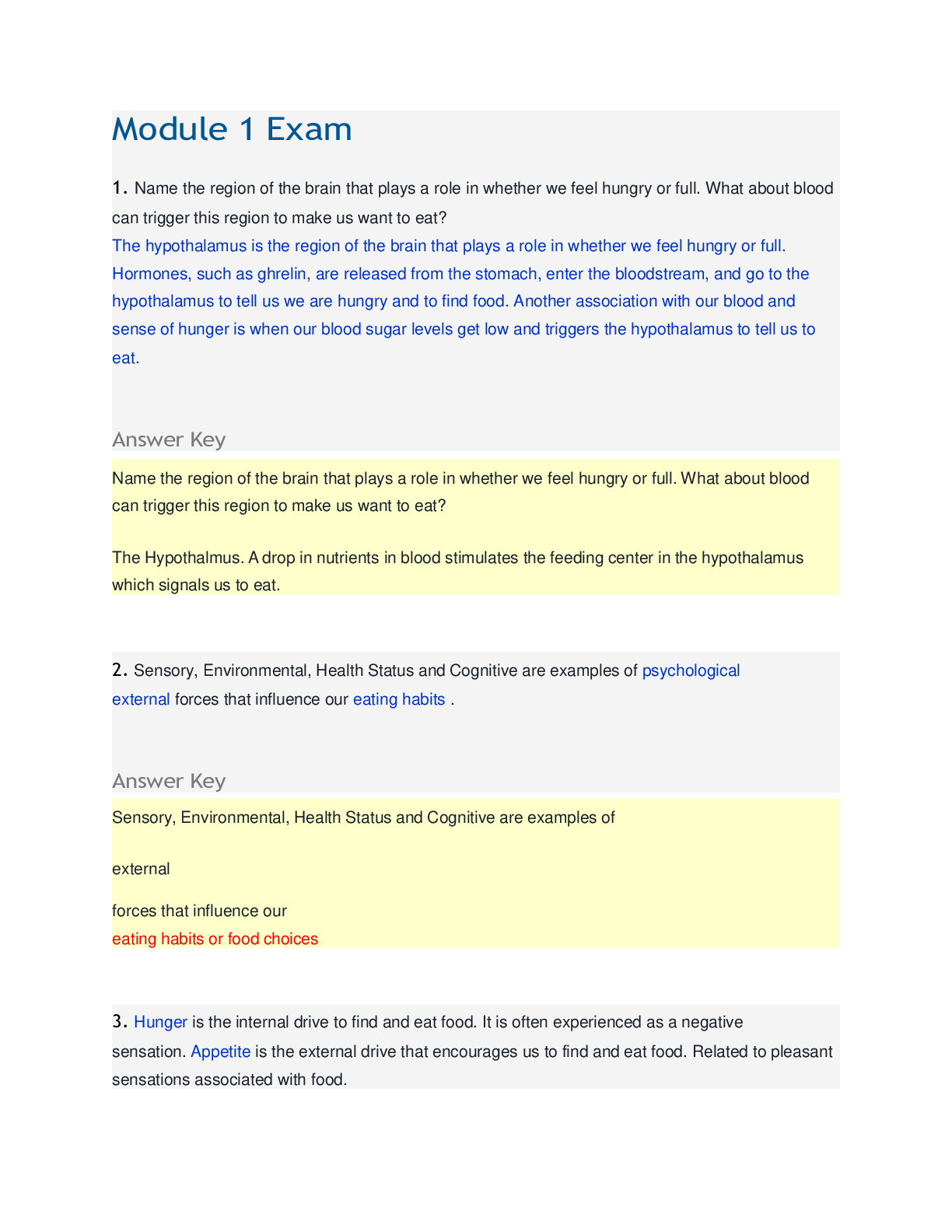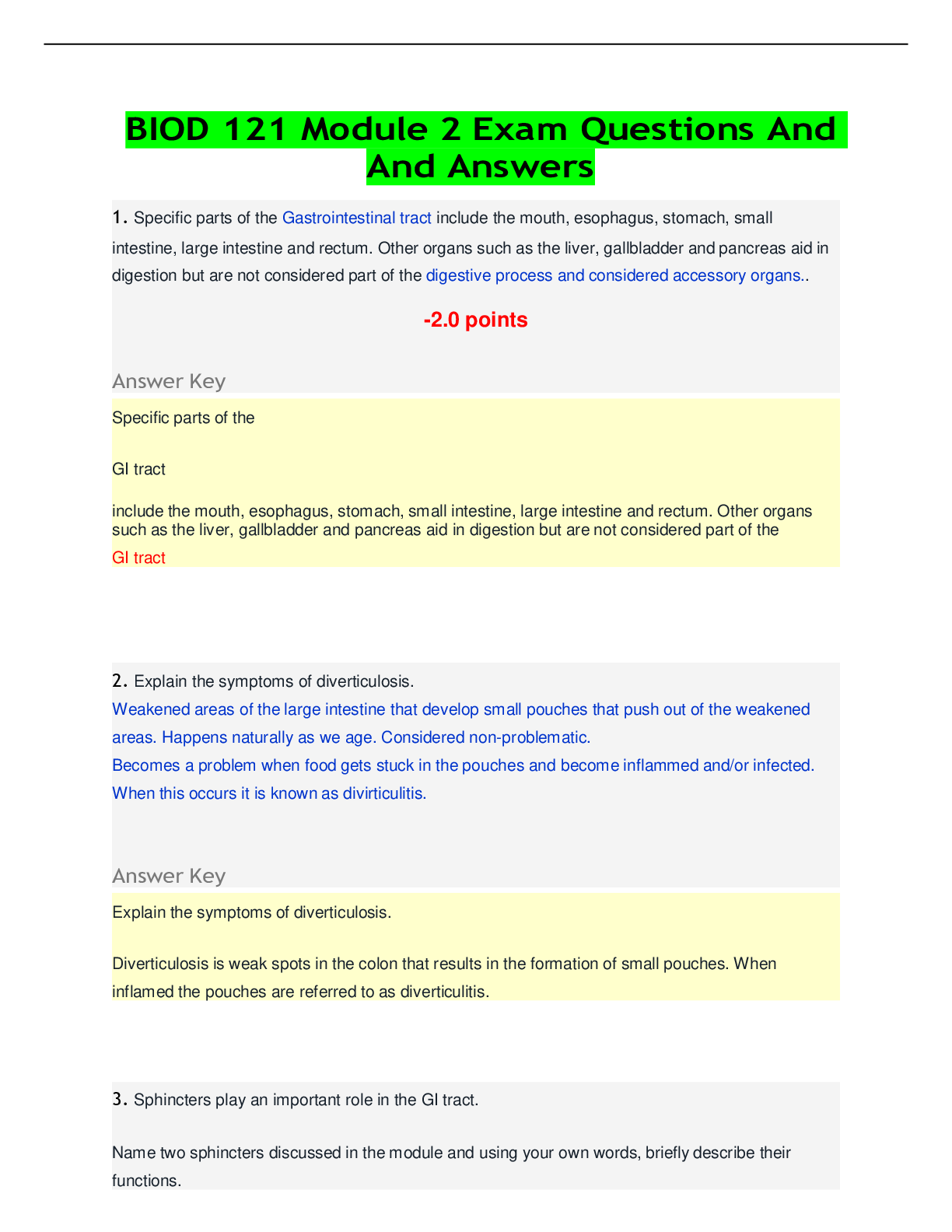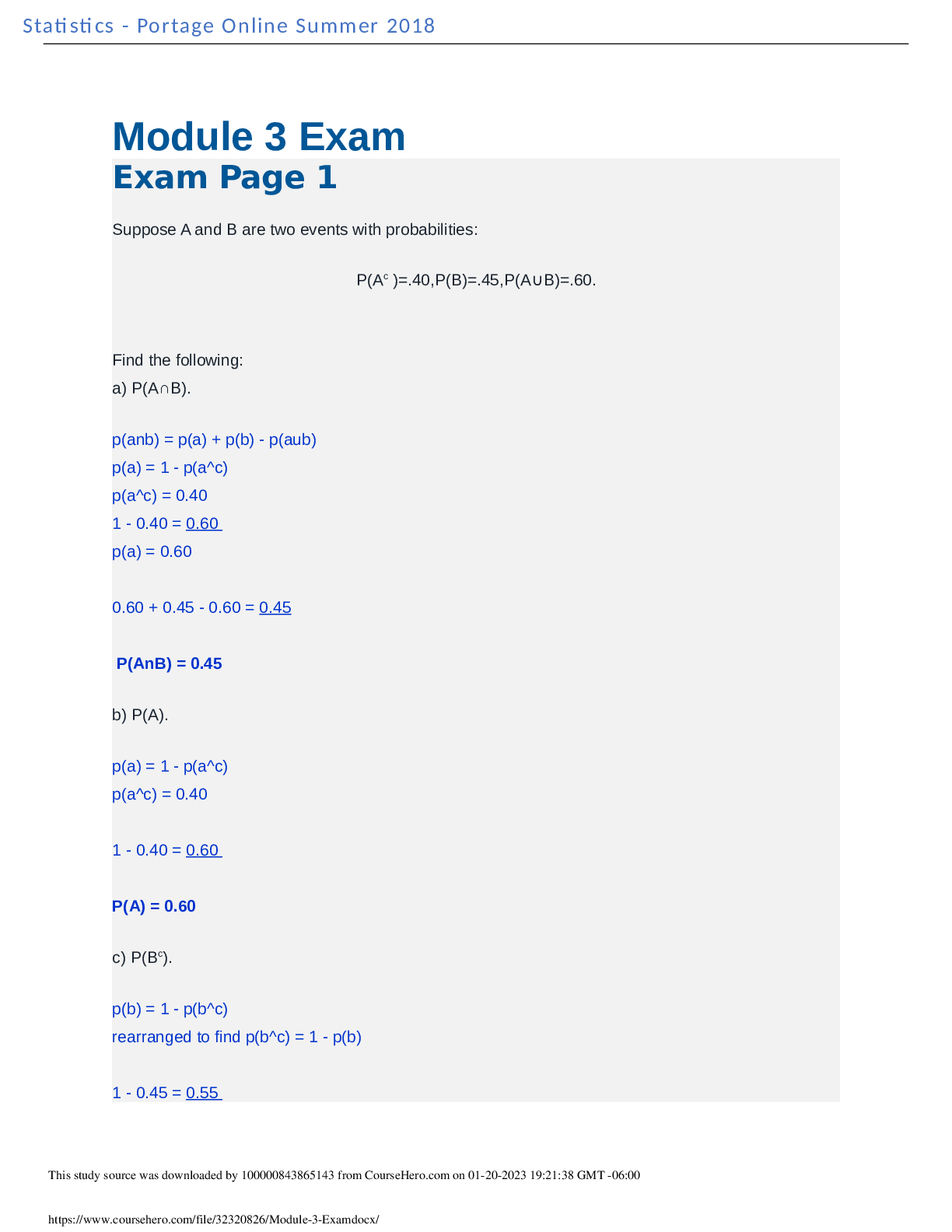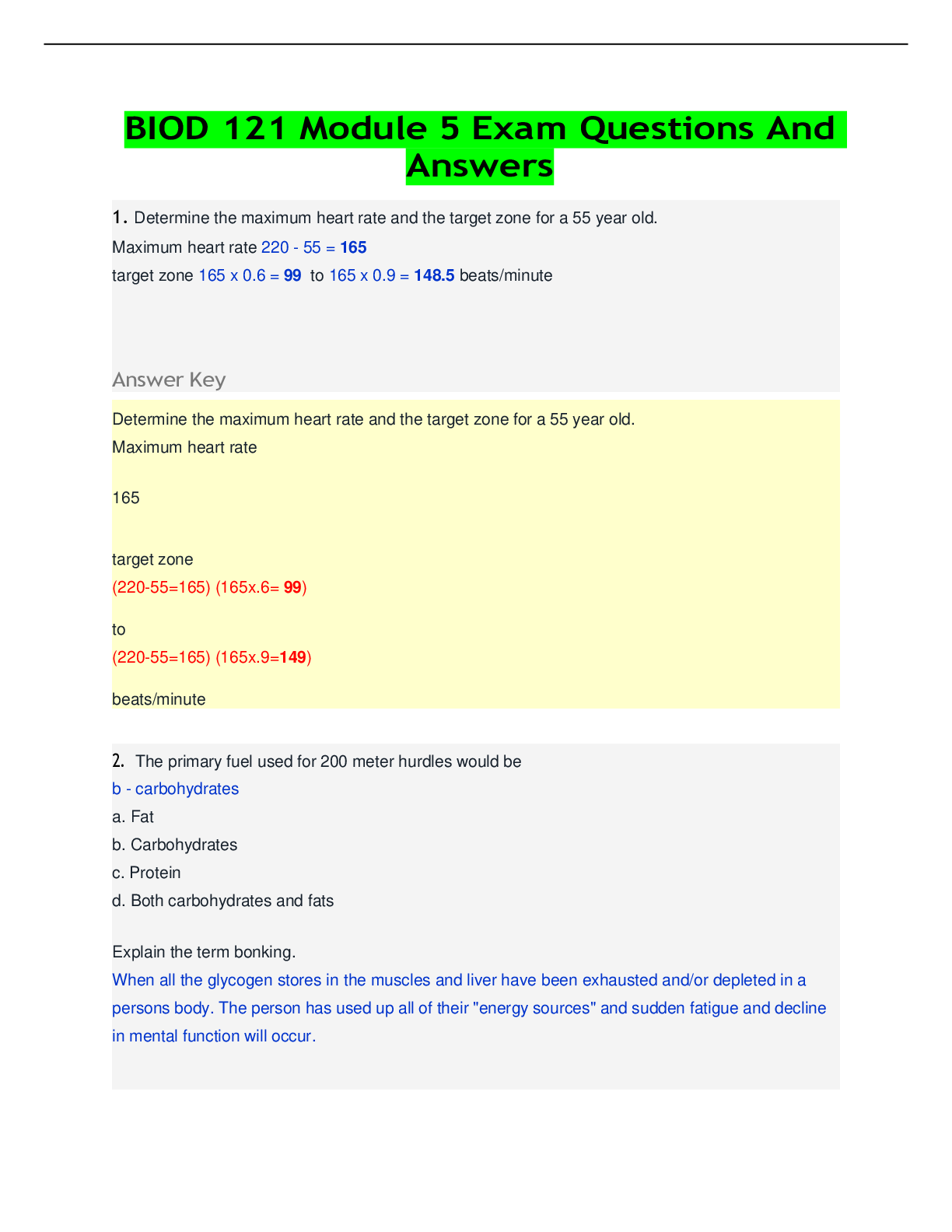*NURSING > EXAM > Test-Bank-for-Contemporary-Maternal-Newborn-Nursing-8E-8th-Edition./ NUR 101 with rationales and ans (All)
Test-Bank-for-Contemporary-Maternal-Newborn-Nursing-8E-8th-Edition./ NUR 101 with rationales and answers
Document Content and Description Below
Ladewig, Contemporary Maternal-Newborn Nursing, 8/E Chapter 02 Question 1 Type: MCSA While conducting a family assessment, the nurse determines that a particular family's structure is binuclear. S... ome potential challenges inherently faced by binuclear families include: Question 2 Type: MCSA The nurse is preparing a community presentation on family development. Which of the following statements should the nurse include? Question 3 Type: MCSA The nurse is preparing to assess the development of a family new to the clinic. The nurse understands that the primary use of a family assessment tool is to: Question 4 Type: MCSA The registered nurse is caring for a pregnant Muslim patient who is anticipating delivery within the next few days. The nurse asks if she and her husband have chosen a name for their baby. The patient quietly shakes her head, "no." Based upon the patient's response, the nurse understands that: Question 5 Type: MCSA A woman of Korean descent has just given birth to a son. Her partner wishes to give her sips of hot broth from a thermos he brought from home. The patient has refused your offer of ice chips or other cold drinks. The nurse should: Question 6 Type: MCSA The nurse works in a facility that cares for patients from a broad range of racial, ethnic, cultural, and religious backgrounds. Which statement should the nurse include in a presentation for nurses new to the facility on the patient population of the facility? Question 7 Type: MCSA The nurse manager in a hospital with a large immigrant population is planning an in-service. The nurse manager is aware of how ethnocentrism affects nursing care. Which statement should the nurse manager include? “The belief that one’s own values and beliefs are the only or the best values: Question 8 Type: MCSA When preparing to teach a culturally diverse group of childbearing families about hospital birthing options, in order to be culturally competent, the nurse should: Question 9 Type: MCSA The nurse is admitting a Mexican woman scheduled for a cholecystectomy. The nurse uses a cultural assessment tool during the admission. Which question would be most important for the nurse to ask? Question 10 Type: MCSA The labor and delivery nurse is caring for a laboring patient who has asked for a priest to visit her during labor. The patient’s mother died during childbirth, and although there are no complications during the patient’s pregnancy, she is fearful of her own death during labor. What is the best response of the nurse? 1. “Nothing is going to happen to you. We’ll take very good care of you during your birth.” 2. “Would you like to have an epidural so that you won’t feel the pain of the contractions?” 3. “The priest won’t be able to prevent complications and might get in the way of your providers.” 4. “Would you like me to contact your parish or our hospital chaplain to come see you?” Correct Answer: 4 Rationale 1: Avoid statements of false reassurance, as there are no guarantees in the outcomes during health care. Using these statements shuts down effective communication, as the patient’s concern is downplayed. Rationale 2: The patient’s expressed concern is not about pain; it is a fear of death and a desire to see a priest. Address the patient’s concerns directly. Rationale 3: Although this statement is true, it is not therapeutic. It downplays the patient’s concerns and will shut down effective communication. Address the concerns the patient expresses. Rationale 4: When the patient states she wants to see a priest, the nurse should attempt to make arrangements for this visit to occur in a timely manner. Most hospitals have a chaplaincy department that can provide assistance in obtaining the services of a wide variety of religious leaders. Depending on the day of the week and the time of day, the patient’s own home parish church might be able to provide a priest for pastoral care at the bedside. Global Rationale: Cognitive Level: Evaluating Client Need: Psychosocial Integrity Client Need Sub: Nursing/Integrated Concepts: Nursing Process: Planning Learning Outcome: LO07 - Identify ways a nurse might accommodate the religious rituals and practices of the childbearing family. Question 11 Type: MCSA A pregnant patient reports experiencing occasional gastroesophageal reflux. She explains that she relieves her symptoms through acupressure treatments, as well as by taking an over-the-counter medication recommended by her obstetrician. The nurse recognizes acupressure to be a form of: 1. Homeopathy. 2. Alternative therapy. 3. Biofeedback. 4. Complementary therapy. Correct Answer: 4 Rationale 1: Homeopathy entails using diluted amounts of substances that, if ingested in larger amounts, would produce effects similar to the symptoms of the disorder being treated. Rationale 2: Alternative therapy involves the use of a procedure or substance in place of conventional medicine. Rationale 3: Biofeedback control pertains to using the mind to control physiologic responses based on the concept that the mind controls the body. Rationale 4: Complementary therapy incorporates the use of a procedure or product as an adjunct to conventional medical treatment. Global Rationale: Cognitive Level: Analyzing Client Need: Physiological Integrity Client Need Sub: Nursing/Integrated Concepts: Nursing Process: Evaluation Learning Outcome: LO08 - Distinguish among complementary and alternative therapies. Question 12 Type: MCSA A patient reports using "homeopathic remedies" to ease her back pain. In order to more fully explore the patient's use of complementary and alternative medicine (CAM), the nurse should ask: 1. "Will you tell me more about the homeopathic remedies you're using?" 2. "Are you aware that some complementary and alternative therapies can be dangerous?" 3. "Does your physician approve of your use of homeopathic remedies?" 4. "Have you prioritized your need for comfort above your concern for your baby's health?" Correct Answer: 1 Rationale 1: The nurse should ask direct, nonjudgmental questions when seeking to gain information about a patient's use of CAM. Rationale 2: While tactful warnings regarding the use of CAM may be appropriate, the nurse should first explore the patient's use of CAM in a nonjudgmental manner. Rationale 3: Patients may be reluctant to discuss their use of CAM with their healthcare providers; the nurse should explore the topic using nonjudgmental language. Rationale 4: Additional information is needed in order to evaluate the patient's use of CAM, and the topic should be approached without use of disparaging comments. Global Rationale: Cognitive Level: Applying Client Need: Health Promotion and Maintenance Client Need Sub: Nursing/Integrated Concepts: Nursing Process: Planning Learning Outcome: LO08 - Distinguish between complementary and alternative therapies. Question 13 Type: MCSA The patient pregnant with her first child reports that her husband wants her to visit a homeopath for help with her nausea and vomiting. The patient asks what the nurse’s opinion of homeopathy is. The best response by the nurse is: 1. “Homeopathy is unproven and potentially dangerous. Avoid using homeopathic remedies.” 2. “The FDA has approved homeopathic remedies, and practitioners undergo education and certification.” 3. “I can’t give you advice about what alternatives to try. Go online and do some research to get information.” 4. “Homeopathy is the same as herbal remedies. Some are safe during pregnancy and some are not.” Correct Answer: 2 Rationale 1: Homeopathic remedies are not dangerous. Homeopathic remedies are FDA-approved and have been proven to be effective in treating a wide range of chronic and acute illnesses and conditions. Rationale 2: Homeopathic remedies are FDA-approved and have been proven to be effective in treating a wide range of chronic and acute illnesses and conditions. Rationale 3: It is appropriate for the nurse to provide factual information to educate a patient who has asked a question. Not all patients have access to computers, nor do they know how to do an internet search. Rationale 4: Herbalism and homeopathy are not the same. Herbs are available in many stores and preparations; some have been proven to be dangerous during pregnancy. Homeopathy is a system of “like curing like,” in which the symptom being treated would be a symptom of taking too much of the substance in a non-homeopathic form. Global Rationale: Cognitive Level: Evaluating Client Need: Health Promotion and Maintenance Client Need Sub: Nursing/Integrated Concepts: Nursing Process: Implementation Learning Outcome: LO09 - Describe the benefits and risks of the various complementary and alternative therapies to the childbearing family. Question 14 Type: MCMA Complementary and alternative therapies have many benefits for the childbearing family and others. However, many of these remedies have associated risks. Which of the following situations would be considered risks? Standard Text: Select all that apply. 1. Getting a massage from a licensed massage therapist for back pain, prescribed by the primary caregiver 2. Trying out a homeopathic medicine from a friend to reduce swelling in the legs 3. Getting a chiropractic treatment for low back pain due to discomforts of pregnancy without telling the primary health care provider 4. Taking an herbal preparation suggested by a health food store worker for treatment of leg pain 5. Joining a group that practices tai chi weekly to help with physical fitness and movement Correct Answer: 2,3,4 Rationale 1: Getting a massage from a licensed massage therapist for back pain, prescribed by the primary caregiver, is a perfectly good use of complementary therapies. Rationale 2: Trying out a homeopathic medicine from a friend to reduce swelling in your legs is a risk factor when considering these therapies. Lack of standardization, lack of regulation and research to substantiate their safety and effectiveness, and inadequate training and certification of some healers make some therapies risky. Rationale 3: Getting a chiropractic treatment for low back pain due to discomforts of pregnancy without telling the primary health care provider is a risk factor when considering these therapies. Lack of standardization, lack of regulation and research to substantiate their safety and effectiveness, and inadequate training and certification of some healers make some therapies risky. Rationale 4: Taking an herbal preparation suggested by a health food store worker for treatment of leg pain is a risk factor when considering these therapies. Lack of standardization, lack of regulation and research to substantiate their safety and effectiveness, and inadequate training and certification of some healers make some therapies risky. Rationale 5: Joining a group that practices tai chi weekly to help with physical fitness and movement is a perfectly good use of complementary therapies. Global Rationale: Cognitive Level: Evaluating Client Need: Safe Effective Care Environment Client Need Sub: Management of Care Nursing/Integrated Concepts: Nursing Process: Evaluation Learning Outcome: LO09 - Describe the benefits and risks of the various complementary and alternative therapies to the childbearing family. Question 15 Type: MCSA The labor and delivery unit nurse manager is incorporating complementary and alternative therapies into the unit’s policies and procedures. Which statement should the nurse manager include during an in-service educational presentation for the nursing staff? 1. “Policies have been developed for using massage and aromatherapy.” 2. “When patients ask questions you don’t know, tell them to look online.” 3. “Because herbs are dangerous during pregnancy, we will not use them.” 4. “Be sure to ask patients what alternative therapies they have used.” Correct Answer: 1 Rationale 1: The development of written policies and procedures facilitates safe nursing practice, which in turn promotes patient safety. Rationale 2: Online information can vary in its accuracy. Reputable sources (electronic or print) should be recommended for further patient education. Rationale 3: This statement is false. Many herbs can be safely used during pregnancy. Rationale 4: What the patient has used in the past does not predict what she is open to using at present. It is more important to develop written policies and procedures. Global Rationale: Cognitive Level: Evaluating Client Need: Physiological Integrity Client Need Sub: Nursing/Integrated Concepts: Nursing Process: Planning Learning Outcome: LO10 - Formulate nursing care within the nurse practice act and with the informed consent of the patient when using appropriate complementary therapies with childbearing families. [Show More]
Last updated: 1 year ago
Preview 1 out of 13 pages
Instant download
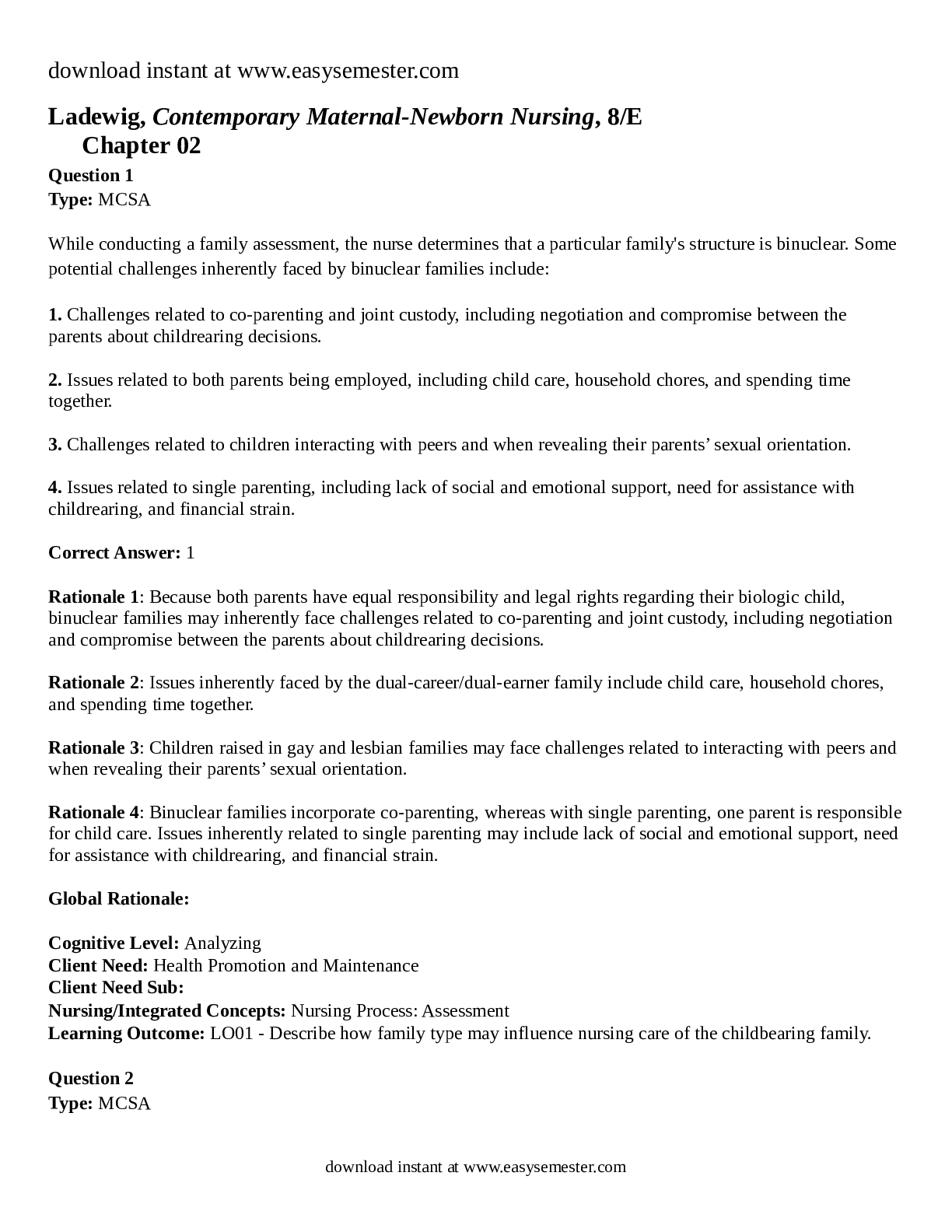
Buy this document to get the full access instantly
Instant Download Access after purchase
Add to cartInstant download
Reviews( 0 )
Document information
Connected school, study & course
About the document
Uploaded On
Aug 01, 2021
Number of pages
13
Written in
Additional information
This document has been written for:
Uploaded
Aug 01, 2021
Downloads
0
Views
37

